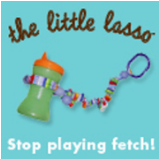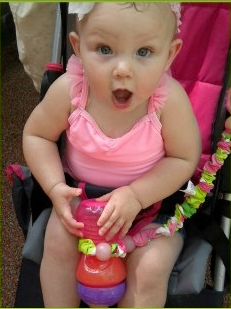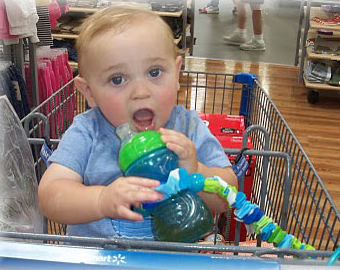Interview with Entrepreneur and The Little Lasso Inventor Angie Wagner
 Simple solutions to common problems are worth a lot in the durable baby products (a.k.a. baby durables) market. No one knows that better than local Austin entrepreneur Angie Wagner, owner of Baby Goga LLC and inventor of “The Little Lasso.”
Simple solutions to common problems are worth a lot in the durable baby products (a.k.a. baby durables) market. No one knows that better than local Austin entrepreneur Angie Wagner, owner of Baby Goga LLC and inventor of “The Little Lasso.”
Established in 2009, Baby Goga has quickly established itself as an up-and-comer in the baby durables industry, an industry slated to grow from $2.8 billion in 2012 to $6.19 billion by 2015. This growth is largely propelled by an increased number of people delaying childbirth; these older parents tend to have more wealth and are therefore more willing to buy high-end childcare products like video monitors. In this installment of Successful Women Entrepreneurs, Angie shares how she used Facebook and customer complaints to break into such a competitive industry.
Thank you for taking the time to meet with me. To get started, could you tell us a little about Baby Goga, LLC, and specifically how you came up with the idea for your flagship product The Little Lasso?
Thank you for having me, Jennifer. Prior to designing The Little Lasso, I patented, manufactured, and sold a product for nursing mothers and a baby bottle warmer which we sold at national baby expos in cities like Atlanta, Chicago, Dallas, and Houston. We noticed a huge influx of tethering items for bottles, leashes for toys, straps for sippy cups. It was getting to the point where if you looked into a baby carrier, you would have to look through a web of contraptions, clips, and links holding everything that baby might ever need right in its face. But the products were getting better and gaining popularity so we decided to stock and carry inventory of these items to sell side-by-side with our current product line at the expos.
As we were on the road, customers told us what they liked about the tether we carried, but more importantly what they did not like. My kids were too old for these products by this point, so we had to listen to what the customers that were actually using these products thought. Of those things, most important was that parents didn’t like Velcro because their toddlers immediately figured out how to undo it. They didn’t like snaps because they too could be easily removed and wore out quickly. We also discovered it was important to be able to adjust the leash length depending on what the tether is being secured to – jogger strollers were typically lower to the ground and some of the straps allowed items to drag on the ground. Parents were frustrated by not finding a one-size-fits-all solution to their daily challenges and that the current offerings were often more complex to secure than a medieval chastity belt.

After that first expo and seeing yet more tethers being offered, I started mulling over all the things the customers did not like about those currently on the market. I took this long list of dislikes and started to work from there, in a sense working backwards. First I figured out a solution to each complaint, and then I was able to come up with a design that was not only able to fit virtually any item, but one that was also length adjustable. Best of all, I came up with a way to make our tether’s grip tighten instead of loosen when a child tugged on or tossed the attached item. I couldn’t wait to get my sewing machine out and start working. After a few prototypes and tweaks, we settled on a design and were ready to launch.
 How many prototypes were there? How did you know what to tweak?
How many prototypes were there? How did you know what to tweak?

There were 4 prototypes. We shared the product with our neighbors and friends with younger kids, welcoming any and all input. We sold our third version for a year before running across someone at a trade show whose father was a tailor and suggested a minor change which we implemented. That small change made the Little Lasso easier and less expensive to manufacture, not to mention better looking.. That is the design we have used for the last 4 years.
How and when did you decide to start selling your invention?
After developing the third prototype, I made a few and we took them on the road with us to an expo show in Dallas and they were a huge hit. A year later, while at the same expo in Houston where we first carried the other brand of tether, we debuted our own. Customers remembered us from the year before and were excited to see that we had actually taken their suggestions to come up with an improved, functional, and trendy design. From there, we started selling at a small local artisan shop as well as in 3 local boutiques on consignment.
Now the Little Lasso is sold in stores across the United States and even some retail stores in Canada. How were you able to get your product in these stores?
I think it is largely because The Little Lasso is a well-made, well-designed product that simply solves a frustrating daily challenge caregivers face. That kind of product always spreads well through word-of-mouth and word-of-mouth exposure is always great for entrepreneurs. We also work with two awesome sales rep companies — one in the Dallas Kids World Market and one in Canada.
 With a background in sales and marketing, you’ve put that experience to very good use with your outreach and advertisements through Facebook. How did you learn to market using social media so successfully?
With a background in sales and marketing, you’ve put that experience to very good use with your outreach and advertisements through Facebook. How did you learn to market using social media so successfully?

Social media 6 years ago was very different and not the complex beast it is today; it was more entrepreneur-friendly. For a new, small company like mine, we had to rely on free or next-to-free advertising which is what social media was back then. Mommy Bloggers, like Making Time for Mommy, GeekMommy Reviews, and Have Sippy Will Travel, were just starting to storm the internet and were eager to share new products with their followers and offer giveaways. It was a “you-scratch-my-back, I’ll-scratch-yours” situation, ideal for any entrepreneur. Everything was new and everyone, including a few other entrepreneurs, were trying to figure out who they were, what to offer and where they would fit in. They wanted to hold giveaways and we wanted exposure for our products, which was a win-win situation. Again, it was a perfect situation for entrepreneurs.
Facebook was essential because it was a free way to connect directly with our customers. It was simple and new and people were more candid on Facebook than they are now. Sometimes we ran contests and did giveaways of our own. We used our creativity to get ‘fans’ and control the direction of our advertising. There were fewer entrepreneurs, companies, and people on Facebook back then to compete with, so when we posted on our fan page, each and every fan saw it. We set advertising preferences to “friends of fans” or people whose interests included “cloth diapering”, “The Real Housewives of Orange County”, “Pampers” or “Twilight” or people who followed other Facebook pages like “Moms who drink wine” or “Disney Resort Vacations” to exponentially expand the reach of our very targeted campaign. We also took advantage of the advertising options; for instance, we could pick exactly who would see our ads based on the interests they set for themselves. We could turn our ads off at certain times of the day when people wouldn’t be online, or turn it on when mothers were chomping at the bit to get online, especially naptime. It was easy to for us to figure out who we wanted to reach and we quickly honed in on them. But most importantly it was a great way to see what others were doing, what was trending, and how to be different. It is somewhat different today – advertising is not as cheap and there is more competition.
Do you think Facebook is still as valuable as it was in the past?
Absolutely. Despite the changes, I still pretty much only use Facebook for my marketing efforts and would still strongly recommend other entrepreneurs use it. I’ve found it more credible for my fans to answer questions from prospective customers than it would be coming from me and my Facebook Fan page is a great resource for that as well as for testimonials. All reviews, giveaways, and daily deal sales that we have going on are announced there. I often still defer to my Facebook fans when looking for a second opinion on my potential fabric selections. Plus I like to be the one to lighten my fans’ days with fun posts.

Do you use other online marketing tools?
I’ve branched out a little bit in the social media realm – my posts from Facebook are linked to my Twitter, but that’s about the extent of tweeting I do. I have started to venture out to Google+, but it is giving me what I call “social-media-mush-head” and I just don’t have the energy or time to learn yet another application. It also doesn’t factor into my marketing plans. Though I do consistently try to work with bloggers as often as possible – they’re still instrumental to my online marketing strategy, as they are to most entrepreneurs.
Are you a stay-at-home entrepreneur?
I am a stay-at-home entrepreneur, or homepreneur, and it is fantastic. Most of my work is in the actual manufacturing of the Lassos. It is a little time on a sewing machine and a lot of handwork. I am actually able to take my work with me almost anywhere – speech therapists, the park, road trips, the car while just driving to go out to dinner with the family, and I’ve even done work on a cruise ship!
What differentiates Baby Goga from other baby products companies?
I believe we are different because of the relationships we have with our customers (both wholesale and retail), our great customer service, and our commitment to quality. Plus we developed our product by listening to our customers. We are so lucky that so many people love to talk candidly and passionately about the negatives of a product because it seems like we learned every negative thing about every product on the market and didn’t have to hold a focus group or conduct a single survey to get those brutally honest opinions. We may not have invented the baby tether, but we developed the best one on the market by addressing each negative aspect of the existing options, and we never would have been able to do that without those vocal customers.
 What are your future plans for The Little Lasso and Baby Goga?
What are your future plans for The Little Lasso and Baby Goga?

I hope to continue growing slowly and steadily. The smaller niche market of boutique stores works well. I have three kids, ages 7, 9, and 11, and I have been able to achieve a sense of organized chaos which is manageable. As the kids get older, I find I have more free time and am able to increase my workload without becoming overcommitted. Someday I hope to be able to have Lassos manufactured here in the US (so I can give my hands a rest), but I don’t see that happening anytime soon. Right now we aren’t in a position to make the financial investment needed to mass manufacture without losing our wide variety of fabric selections, and making that kind of sacrifice just isn’t an option. Realistically, expanding manufacturing slightly — so that I’m not the only one making this product by hand– is in the near future. I’d also settle for being bought out by a larger baby product company with a nice royalty package!
If you could give fellow mom entrepreneurs any advice, what would you tell them?
I’d tell fellow mom entrepreneurs to open your ears and eyes and seek out advice where you can find it. Learn from others’ mistakes and experiences as well as your own. Entrepreneurs inevitably make mistakes along the way – some big, some small, some expensive, but these mistakes may end up being the best thing you ever did.
I would also say that your webpage is your first impression, your eyes, and smile. Nothing says “shoddy and dumpy” like a lack-luster website, bad grammar, and poor spelling, and I hate seeing other entrepreneurs make that mistake. Finally, I believe all entrepreneurs should always focus on the desired end results and work their plan backward from there; it is always easier to finish a maze if you start at the end.
—
CWHighlights thanks Angie for taking the time out to share her adventure in baby products and homepreneurship. Are you a woman entrepreneur, homepreneur, and/or mompreneur? We want to hear your story! Contact Jennifer at [email protected].

